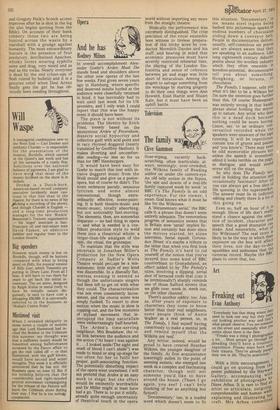Art
Freaking out
Evan Anthony
"Everybody has that thing where theY need to look one way but they OM,: out looking another way and thate what people observe. You see some°110 on the street and essentially what Yt) notice about them is the flaw. "Freaks was a thing I photograPb.ecife a lot ... Most people go through tic ,dreading they'll have a traurna",'h v. experience. Freaks were born "' d their trauma. They've already pass,, • their test in life. They're aristocrats.
With a little encouragement, I could go on quoting from till poster published by the HaYwa„rh Gallery, accompanying vo,`„ exhibition of photographs " Diane Arbus. It is rare to find arl artist so articulate, outgui,_°;g1; comprehensible and human wo"; explaining and illustrating heii craft. Mrs Arbus committe Spectator April 27, 1974 suicide in 1971. Ironically, her
Photographs are among the most alive things to be seen in London today. While capturing on film a number of things that have obviously gone wrong, she presents a life show rather than a freak Show. Bite, along with beauty, is in the eye of the beholder, and so
Diane Arbus's pictures may indeed appear biting, scathing, even inocking to some; there are, cer tainly, those elements in her photographs, but I left the exhibition feeling not that the artist had used
or abused her subjects so much as that here was a lady who really could appreciate the flaws.
The most alive thing about the Vorticism and its Allies exhibition, Sharing the space on the lower floor of the Hayward, is Richard Cork's spiky catalogue dramatisation of the power struggle between the Cubist-Vorticists and
the Futurist-Vorticists. It's a real
Cliff-hanger. As for the movement, its manifesto and
Publication — well, it's all a good try, isn't it, using geometry to
angle-cise while anglicising the Cubist-Futurist 'styles', with Cork stressing his thesis that Wyndham Lewis was not the only Vorticist in this land, no siree. What about Eomberg, William Roberts, Etchells, Epstein, Christopher Nevinson, not to mention Gaudier-Brzeska (whom even Ken Russell admires). But it's a well designed show, authenticating the British contribution to what is still quaintly called 'modern art.' For timelessness in the modern idiom, try Frank Auerbach's latest exhibition at the Marlborough Fine Art, Albemarle Street. It is a splendid show, with :every thick blob of paint making its point. One of the remarkable things about this collection is how adeptly Auerbach performs a series of pictures on a theme Without a hint of repetition of hnPact. The 'Working Drawings for the Mornington Crescent Paintings' and the resulting paintings have an individuality that is enviable. Auerbach uses pigment and colour with passion and as surance, creating an excitement that will not diminish with anuliarity. That's hard to do. From the sublime to the ridiculous, the Serpentine Gallery
and the Rowan Gallery are tied for
this week's banality award. The latter has on display a single glass of water sitting on a glass shelf, „a_nd a printed "interview with michael Craig-Martin" attempts arl explanation: Q: To begin with, could you describe this work? • A: Yes, of course. What I've done is change a glass of water into a fullgrown oak tree without altering the accidents of the glass of water. l'hat's it, more Or less.
„Prom Barrie Bates to Billy Ap Pie (Serpentine) is a fruity effort showing the transformation of 'the 1-tist' from a brunette to a blond, I think. There is also a film to be strie,n, a sure sign that the whole Is is confusing, precious, and a Poor substitute for the Easter niflatables the Serpentine used to show at this time of year.



































 Previous page
Previous page